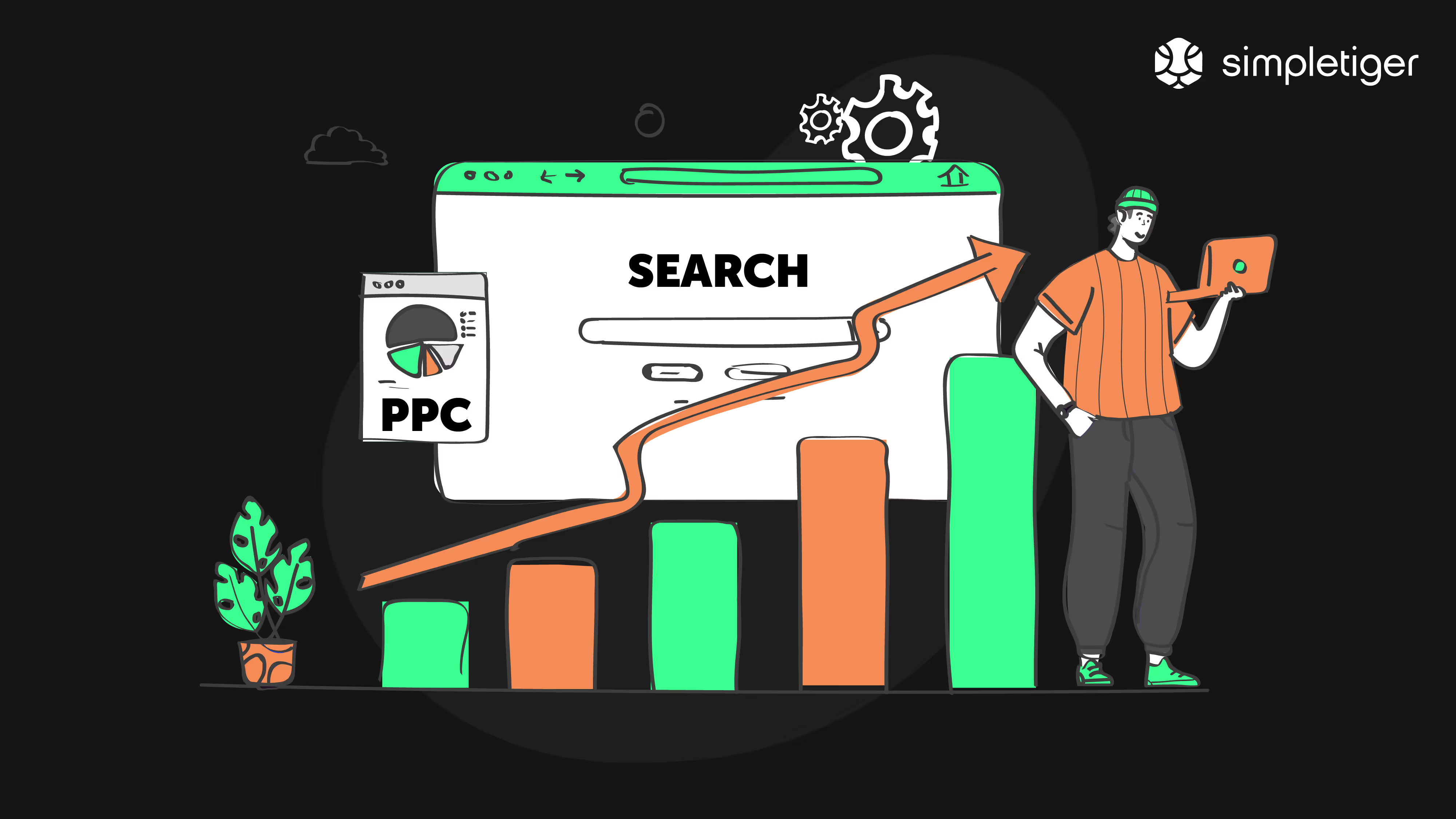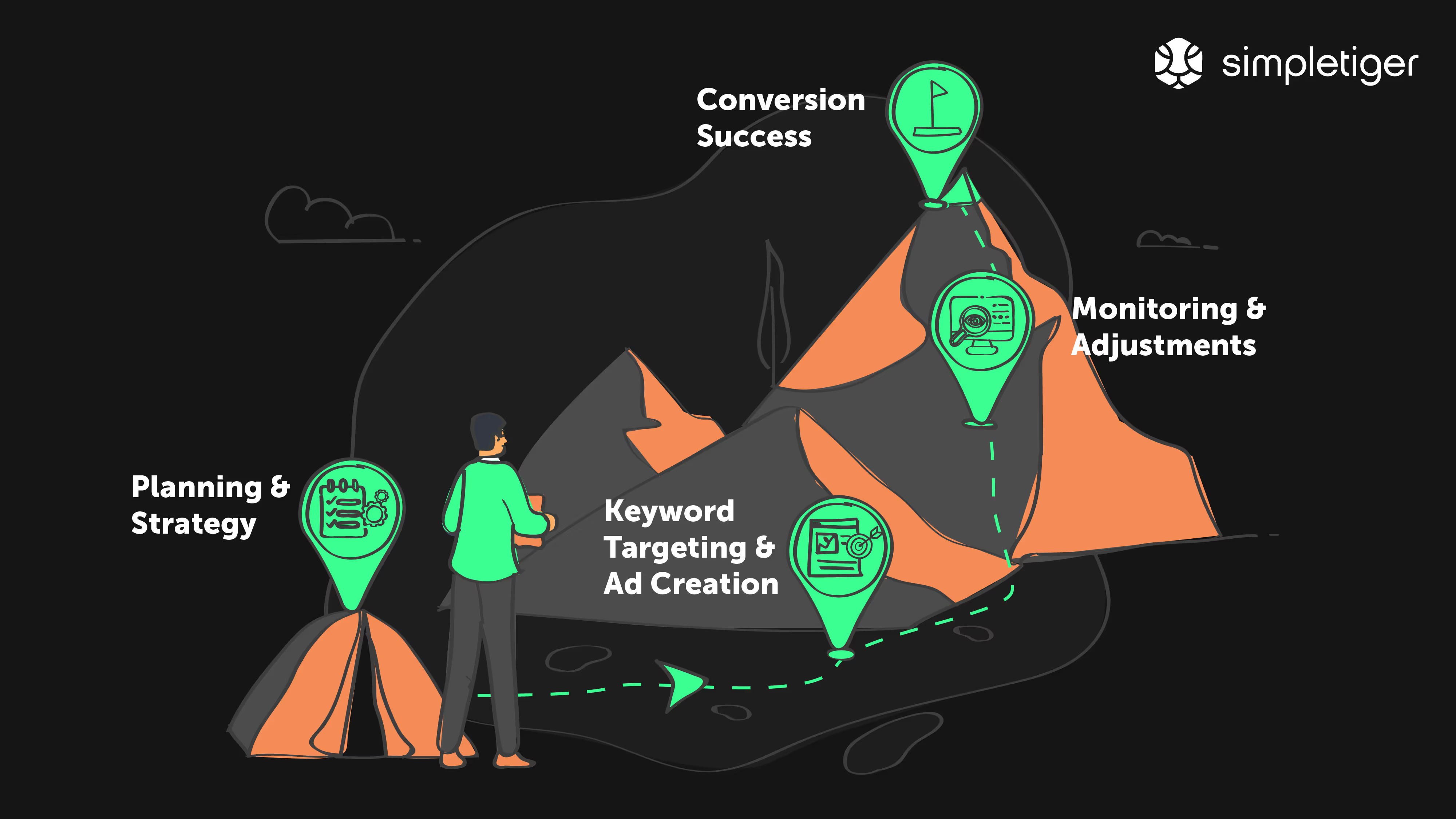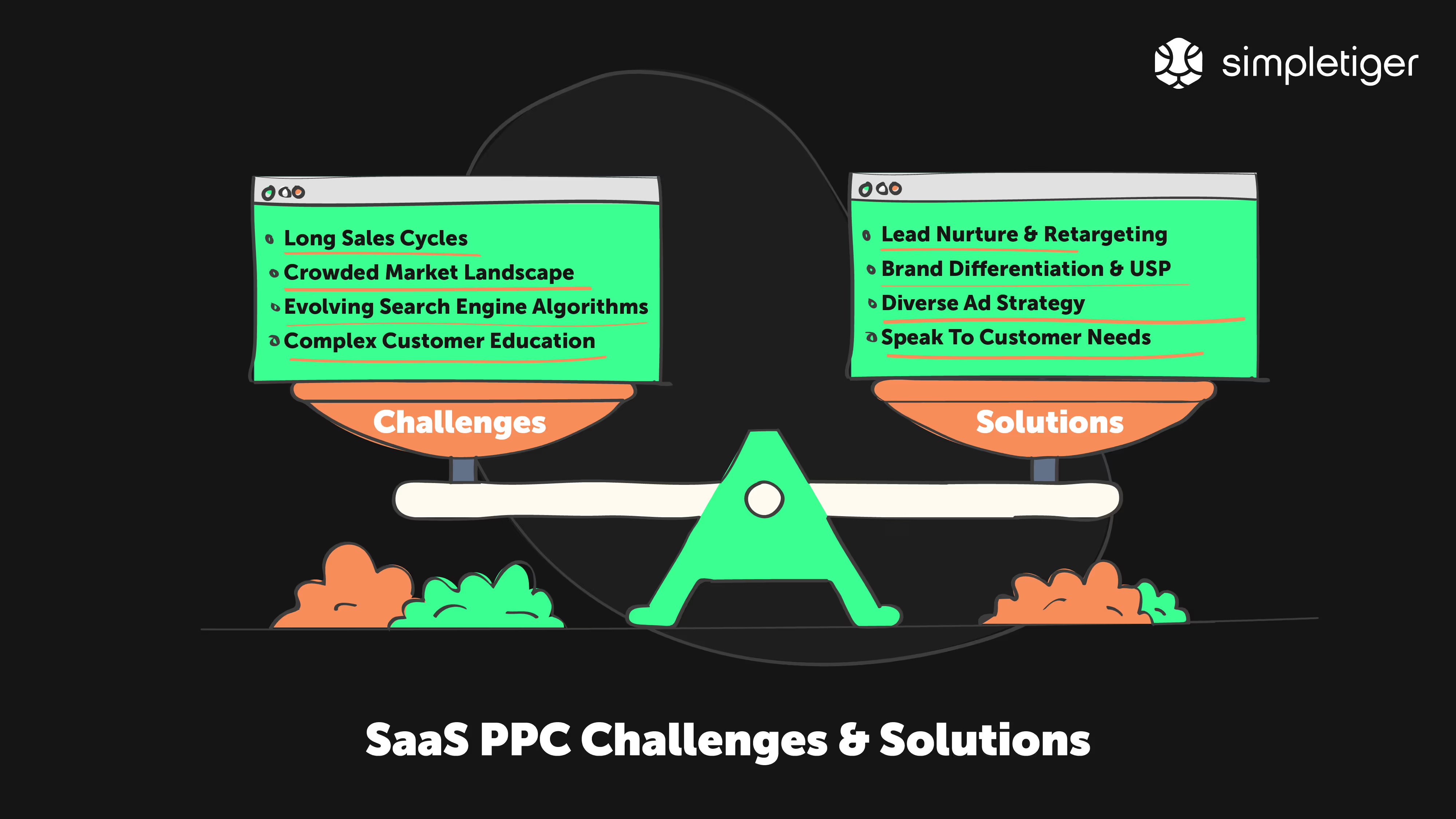Download the SaaS SEO Guide PDF
Over 60+ page SaaS SEO Guide in PDF format so you can read it whenever you want!



Over 60+ page SaaS SEO Guide in PDF format so you can read it whenever you want!








Software as a Service (SaaS) products are everywhere, helping businesses do their work more efficiently. But with so many SaaS options out there, it's hard for companies to get noticed. That's where PPC ads can help SaaS businesses to get their product in front of the right eyes. In this article, we'll break down the steps to set up effective PPC ads for your SaaS product, making it easier to find customers and grow your business.
SaaS PPC stands for Software as a Service Pay-Per-Click. Let's break that down:
So, when we talk about SaaS PPC, we're referring to a specific advertising strategy where SaaS companies use PPC campaigns to promote their cloud-based software solutions. The aim is typically to drive traffic to their website or landing page and encourage sign-ups, trials, or direct software purchases. The challenge and focus with SaaS PPC are not just to get clicks but to convert those clicks into actual subscribers or users of the software.

PPC holds a unique position in the marketing arsenal of SaaS companies. One of its primary benefits is the immediate visibility it provides on search engines. In an industry where competition is fierce and the digital space is crowded, PPC ensures that SaaS businesses can quickly capture attention, drive targeted website traffic, and begin fostering leads and conversions. Unlike organic strategies, which can be time-consuming and gradual, PPC offers almost instantaneous results, allowing even new entrants to gain a foothold in the market swiftly.
PPC's granularity in audience targeting is another crucial advantage for SaaS firms. Platforms like Google Ads allow businesses to tailor their ad campaigns based on specific keywords, locations, devices, and user behaviors. SaaS companies can pinpoint their ads to the demographic most likely to benefit from their software solutions. Additionally, the inherent flexibility of PPC means that ad campaigns can be adjusted on-the-fly based on real-time analytics, ensuring maximum ROI and optimal use of marketing budgets.
Lastly, the SaaS business model often involves longer sales cycles, making customer retention and engagement pivotal. PPC facilitates this by allowing for effective retargeting strategies, keeping potential clients engaged across their decision-making process. Moreover, with the ability to tap into global markets and receive immediate feedback on product messaging, PPC becomes not just a marketing tactic but an essential strategy for growth and market penetration in the SaaS domain.

The foundation of any successful SaaS PPC campaign starts with a deep understanding of your target customer. Identifying and defining your target audience means delving into who they are, what challenges they face, and how your solution addresses those needs.
This involves comprehensive market research, user interviews, and data analysis. The more granular and precise you can be about the characteristics and behaviors of your audience, the more cost-effective your SaaS campaigns will be.
But why is this precision crucial? Tailoring campaigns to meet your potential users' specific needs and stages ensures your messaging resonates with them. It's about speaking their language, understanding their pain points, and showcasing your software as the solution. When you cater your PPC ads and landing pages to distinct buyer personas, you significantly increase the chances of conversion.
Setting clear and actionable objectives is a must before diving into the design and setup of your campaigns. This begins with defining key performance indicators (KPIs) that will act as the compass for your campaign's direction and measure performance success. KPIs could range from click-through rates to cost per acquisition, among others. With these metrics in place, you can consistently evaluate and adjust your campaign strategies.
SaaS companies often have unique objectives compared to other industries when it comes to PPC. Some examples include driving sign-ups for free trials, increasing the adoption of particular software features, promoting webinars or other educational resources, and targeting potential users who may have abandoned carts or not moved past a certain onboarding stage. By understanding and setting these SaaS-specific goals, companies can craft PPC campaigns that directly cater to the needs and behaviors of their target audiences, leading to higher conversions and user satisfaction.
For SaaS companies venturing into PPC, keyword research isn't just a task—it's an art. The key is to leverage tools and strategies tailored to the SaaS niche. Platforms like Ahrefs and Google Keyword Planner can be invaluable in uncovering relevant terms. However, effective keyword selection isn't just about volume; it's about intent. Prioritizing high-intent keywords ensures that your ads are presented to users actively seeking solutions like yours.
While it might be tempting to aim for broad terms with high search volume, it's often wise to avoid generic or overly competitive keywords that can drain your budget without delivering results. Instead, incorporate long-tail keywords. These are longer, more specific keyword phrases that visitors will likely use closer to making a purchase or subscription decision. They may have lower search volumes but often have higher conversion rates due to their specificity.
Your ad copy is the gateway to your software. It must catch a user's eye and convey the value of your software within seconds. Start with attention-grabbing headlines. These should resonate with the pain points or desires of your target audience. Once you've captured attention, communicate the benefits of your software concisely and persuasively.
Given the limited space in PPC ads, every word must count. Strong calls to action (CTAs) are the backbone of effective ad copy, guiding users on the next steps. Phrases like "Start Your Free Trial" or "Discover the Difference" can be powerful motivators. To ensure your ad copy is as effective as possible, employ A/B testing. This involves running two ad versions to see which performs better in terms of clicks, conversions, and other metrics.
Landing pages are where the PPC magic happens. They bridge a user's click and your desired conversion action. Therefore, the importance of landing page optimization cannot be overstated. A successful SaaS landing page often starts with a clear UVP (Unique Value Proposition). This tells visitors immediately what your software does and why it's better or different from others. Following the UVP, incorporate social proof elements, such as testimonials and case studies. These build trust and credibility, showing potential users that others have benefited from your software.
Strong CTAs and appealing lead magnets, such as downloadable resources or webinar sign-ups, can guide visitors toward conversion. Lastly, ensure your landing page delivers a seamless user experience. This means fast load times and mobile optimization to cater to users across all devices. Remember, even the most compelling content won't convert if users abandon a slow-loading or poorly designed page.
In the dynamic realm of PPC advertising for SaaS products, utilizing all available features can give you an edge over competitors. Ad extensions, for instance, are a powerful tool that can enhance the visibility and appeal of your paid ads. There are various extensions tailored for SaaS offerings, including site links that guide users directly to specific pages of your site, structured snippets that showcase particular software features, and callouts that highlight exclusive offers or unique selling points.
Beyond these, leveraging advanced features like remarketing tags can keep your product top-of-mind for potential buyers. By implementing these tags, you can specifically target your ad groups to users who've previously interacted with your brand, delivering tailored ads that resonate with their past behavior. Additionally, audience lists enable you to segment and target your ads based on user demographics, interests, and more, making your campaigns even more precise.
Ensuring a positive return on investment starts with astute budgeting. For SaaS PPC campaigns, setting a realistic budget means considering factors like the average lifetime value of a customer and the costs associated with customer acquisition. With a budget in place, you'll next need to tackle bidding strategies. There are various approaches, such as cost-per-click (CPC) bidding, cost-per-acquisition (CPA) bidding, or even automated bidding based on preset objectives.
The key is to choose a strategy aligned with your campaign goals. For instance, CPC might be preferable if brand visibility is the primary aim. However, CPA could be more fitting if conversions are the end goal. No matter the strategy, it's paramount to monitor bids actively. Adjustments based on performance metrics can help optimize your ad budget and maximize ROI.
Once your campaign is live, the journey is far from over. Monitoring, measuring, and analyzing are crucial next steps. Thankfully, there's no shortage of tools and platforms for tracking PPC metrics. Google Ads provides comprehensive insights, but platforms like Google Analytics can also offer valuable data.
When diving into the numbers, consider metrics like CTR (click-through rate), conversion rate, and cost per acquisition. These figures provide a direct window into the efficacy of your campaigns. However, raw data is only as useful as the insights drawn from it. Regularly interpreting these metrics allows for more informed decisions moving forward. And remember, the world of PPC is ever-evolving. Continuous optimization, based on performance analysis, is the linchpin of long-term success.
In today's digital age, the mobile device has carved out a significant niche in the SaaS buyer's journey. With consumers routinely using phones and tablets to discover, research, and even purchase software solutions, ensuring your campaigns are optimized for these platforms is essential. This means ensuring ads display correctly on smaller screens and that landing pages and other destinations are mobile-responsive.
The goal is to provide a seamless experience irrespective of the device. But optimizing campaigns for mobile isn't just about display; it's also about understanding user behavior. Recognize that a user may begin their journey on one device and complete it on another. Thus, tracking and optimizing for cross-device conversions becomes crucial. Cross-device tracking platforms can give you insights into user behaviors, allowing you to tailor your campaigns more effectively to different audiences.
Not every visitor will convert immediately, even with a perfectly crafted PPC campaign. Enter remarketing—a powerful tool to re-engage past visitors by displaying targeted ads based on their previous interactions with your site or product. Reminding them of their initial interest increases their likelihood of returning and converting.
Another advanced tactic is deploying lookalike audiences. Platforms like Facebook allow you to target users who share characteristics with your current audience or customer base, thus potentially expanding your reach to those more likely to be interested in your SaaS offering. It's vital to adhere to best practices when employing these tactics, particularly in targeting and ad creatives. Ensure that your remarketing ads are relevant and not overly intrusive. Personalized, engaging ad content can go a long way in driving conversions.
Once you've laid the groundwork and have campaigns running, the next step is to identify what's working and scale those successes. This means routinely analyzing campaign data to pinpoint high-performing ads, keywords, or audience segments. Once identified, incrementally increasing budgets for these top performers can yield even greater returns.
It's all about fueling what works and cutting back on what doesn't. But scaling isn't confined to just amplifying current campaigns. As you gather more data and insights, consider expanding your reach by venturing into new channels and platforms. Each platform has its unique audience and characteristics, offering opportunities to tap into new segments of potential users. Always remember scaling should be a strategic and measured effort, ensuring that growth doesn't compromise the ROI or the quality of leads.

Unlike eCommerce or simple service providers, where users might convert instantly upon clicking an ad, SaaS products typically involve longer sales cycles. This means that even if a potential customer clicks on a SaaS PPC ad, they might not immediately purchase. Instead, they may wish to explore the product's features, look for reviews, request a demo, or even discuss it with other team members before committing.
Overcoming this challenge: SaaS PPC campaigns should be structured to nurture qualified leads over time instead of just focusing on immediate conversions. Employ retargeting strategies to stay on the prospect's radar, offer valuable content or webinars, and employ drip email campaigns to guide them down the funnel.
The SaaS industry is booming, leading to many choices for consumers. With so many competitors vying for the same keywords and audience attention, standing out becomes exceedingly tough. This high competition can also lead to inflated keyword bidding prices.
Overcoming this challenge: Differentiate your brand not just through product features but through your ad messaging. Understand your unique selling proposition (USP) and communicate it. Additionally, focus your ad spend on niche or long-tail keywords your competitors might overlook, offering a better return on investment (ROI).
The world of PPC is governed by search engine algorithms, which can change without warning. These changes can drastically affect ad performances, making previous strategies ineffective overnight.
Overcoming this challenge: Always stay updated with the latest changes in paid search advertising platforms. Subscribe to industry news, attend webinars, and consider joining industry forums or groups. Diversifying your ad strategy can also help—instead of putting all your eggs in one basket, spread your efforts across various platforms and ad types.
SaaS products can often be intricate, making it crucial for potential customers to understand their nuances before committing to a purchase. While it might seem daunting to convey such depth in a concise PPC ad, it’s all possible with a strategic approach.
Overcoming this challenge: Start by utilizing the ad to pinpoint a challenge your target audience encounters. This not only grabs their attention but also resonates with their needs. Follow this by offering a glimpse of the core solution your product provides. Instead of overwhelming them on the ad itself, direct the intrigued users to dedicated landing pages. Here, enriched with videos, infographics, and bite-sized content, they can delve deeper into understanding the myriad benefits your product offers. The ultimate goal isn’t just attracting a click, but cultivating a well-informed user who, recognizing the problem you address and the solution you offer, is prepared to invest in your product. Remember, breaking down the complex into a relatable problem-solution narrative can powerfully attract and educate potential customers.
While the inherent challenges of SaaS PPC are multifaceted, they aren't insurmountable. With a strategic, adaptive approach, SaaS companies can leverage PPC to achieve significant growth and market penetration.

While many SaaS businesses enthusiastically leap into the PPC arena, not all come out triumphant. But why do some campaigns soar while others plummet? Understanding common pitfalls is crucial for success. Here are the top eight reasons SaaS PPC campaigns often fail and actionable insights on how to steer clear of them.
By recognizing and addressing these common pitfalls, SaaS businesses can drastically enhance the potency of their campaigns.
In the ever-evolving digital marketing realm, SaaS companies face unique challenges that demand specialized expertise. At SimpleTiger, we're not just any PPC management agency; we're a SaaS-specific agency focusing on driving exponential growth for software businesses. With a rich blend of industry principles, state-of-the-art AI technology, and a tried-and-true playbook of strategies, we prioritize actions that promise the most significant impact, concentrating on the vital 20% that delivers 80% of the results. The SaaS world waits for no one, and neither do we. We're all about swift, effective action.
If you're keen to supercharge your SaaS business with unparalleled PPC strategies, the next step is simple. Book a discovery call with SimpleTiger today and pave the way for accelerated success.

Ian is a PPC Manager at SimpleTiger, responsible for creation, management, iteration, reporting, and optimization of PPC accounts, both paid and social for clients.
Over 60+ pages detailing how to grow your SaaS company using a proven SEO process.


Schedule a Discovery Call and see how we've helped hundreds of SaaS companies grow!




Actionable insights to help you grow your SaaS and dominate your search market!